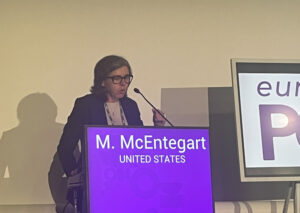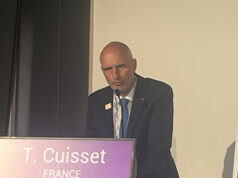
Thirty-day primary endpoint results of EMPOWER CAD, the first prospective, real-world percutaneous coronary intervention (PCI) study in female patients with complex, calcified coronary artery disease have been presented at EuroPCR 2025 (20–23 May, Paris, France).
The favourable results confirm earlier retrospective analyses demonstrating the benefits of coronary intravascular lithotripsy (IVL, Shockwave Medical) in female patients.
Women with coronary artery calcification undergoing PCI are often underrepresented in clinical trials and have historically poorer outcomes than men, including increased risk of adverse clinical outcomes and high rates of procedural complications with other calcium modification treatments, such as rotational or orbital atherectomy.
Investigators designed the EMPOWER CAD study to evaluate real-world outcomes in female patients with severely calcified coronary lesions treated with an IVL-first treatment strategy and confirm positive results from previous studies showing similar safety and effectiveness outcomes across both men and women.
EMPOWER CAD is a pivotal study representing Shockwave’s first prospective, post-market study of IVL examining an all-comers female population with minimal exclusion criteria, the first study to encourage a Shockwave IVL-first PCI strategy for calcified coronary lesions, and the first study to follow-up with enrolled patients for three years following IVL therapy.
The study enrolled 399 participants across 45 sites spanning five countries in the European Union and USA. The study is led by co-principal investigators Margaret McEntegart (Columbia University Medical Center/NewYork-Presbyterian Hospital, New York, USA), who presented the results at EuroPCR, and Alexandra Lansky (Yale University School of Medicine, New Haven, USA). The study’s European lead is Nieves Gonzalo (Hospital Clinico San Carlos, Madrid, Spain).
“Women are typically underdiagnosed, underrepresented and have underwhelming outcomes in coronary artery disease studies,” said Lansky. “Our goal with the EMPOWER CAD study was to address this gap and determine whether Shockwave IVL should be considered as the front-line calcium modification approach in female patients with complex coronary artery disease. The results demonstrate the benefits of IVL use in this specific patient population and validate findings from previous studies.”
The primary effectiveness endpoint of procedural success, defined as stent delivery with ≤30% residual stenosis for all treated target lesions without in-hospital target lesion failure (TLF), was 86.9% at 30 days. The primary safety endpoint, defined as TLF as a composite of cardiac death, myocardial infarction attributable to target vessel (TV-MI) or ischemia-driven target lesion revascularization (ID-TLR) within 30 days, was 12.1%. TLF was primary driven by the rate of periprocedural MI3 (10.6%); the majority of these periprocedural MIs were not associated with any clinical signs or symptoms. Cardiac death and ID-TLR rates were each 1.3%. Procedural complications were rare with only one patient (0.2%) having a serious angiographic complication when assessed at the end of the procedure. There were also clinically and statistically significant improvements in health-related quality of life scores at 30 days compared to baselines.
“By leveraging a Shockwave IVL-first approach, the EMPOWER CAD 30-day results demonstrated high procedural success, low complication rates and significant improvements in quality of life among real-world female patients,” said McEntegart. “While we look forward to following these patients for the next three years, these primary endpoint results confirm that excellent outcomes can be achieved with the use of Shockwave IVL in women with complex, calcified coronary artery disease.”
Nick West, chief medical officer, Shockwave Medical, commented: “Today marks a critical milestone in the journey to improve outcomes for female patients with calcified lesions. What began as an idea a few years ago is now a commendable reality today, thanks to study leadership and site investigators accelerating completion and reporting these important results. We’re looking forward to learning more about the benefits of IVL therapy in this underrepresented patient population, both acutely and at extended follow-up.”










